With a history spanning thousands of years and having gone through countless revolutions, Vietnam has managed to preserve its distinctive cultural traits through its way of life, cuisine, and especially its traditional festivals. Traditional festivals in Vietnam are not only an opportunity for people to gather, but also a chance to express gratitude to their ancestors and to pray for a prosperous, happy, and peaceful life for the country. Festivals in Vietnam are spread throughout the 12 months of the year, each one with its own unique features and stories that clearly represent the identity of the 54 ethnic groups of Vietnam.
So, after reading this article, if you ever have the chance to participate in festivals in Vietnam, it will undoubtedly leave you with unforgettable emotions, and you will understand why the Vietnamese people remain united and proud of their country.
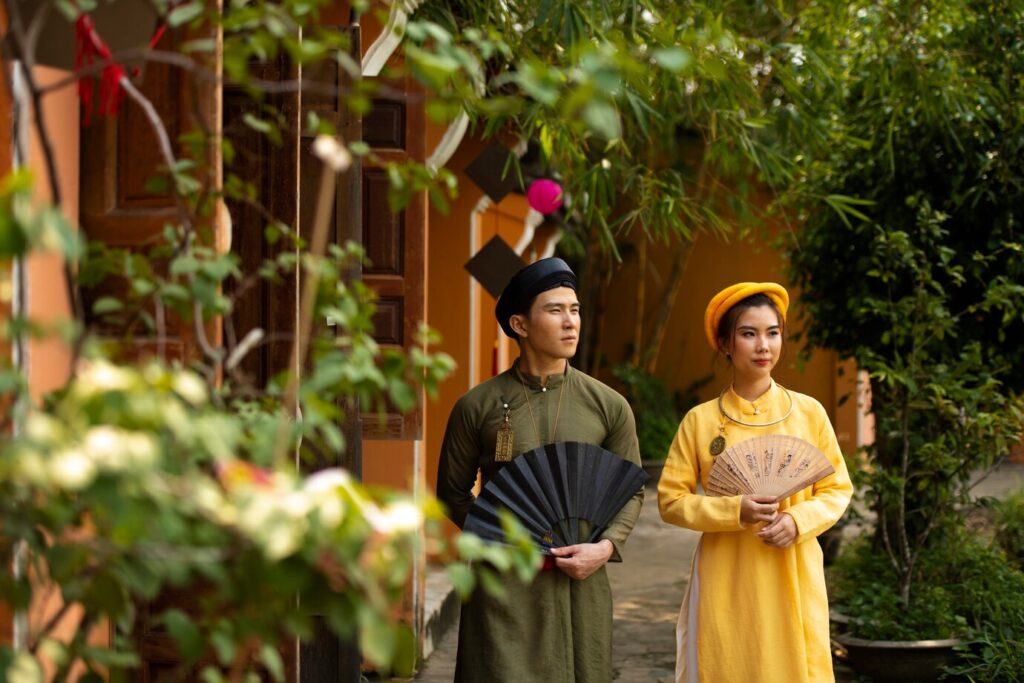
What Makes Festivals in Vietnam So Captivating?
Not only does Vietnam have a rich culinary heritage, but its festivals also attract many tourists who come to immerse themselves in and enjoy the sacred moments of these significant occasions, much like the Vietnamese people. Each festival carries with it deep cultural significance and is seen as an essential part of the soul and spirit of every region. From the lively celebrations of Tết, marking the start of the lunar new year, to folk festivals like the Lim Festival, the Giong Festival, and the Huong Pagoda Festival, they bring joy, laughter, and radiant smiles.
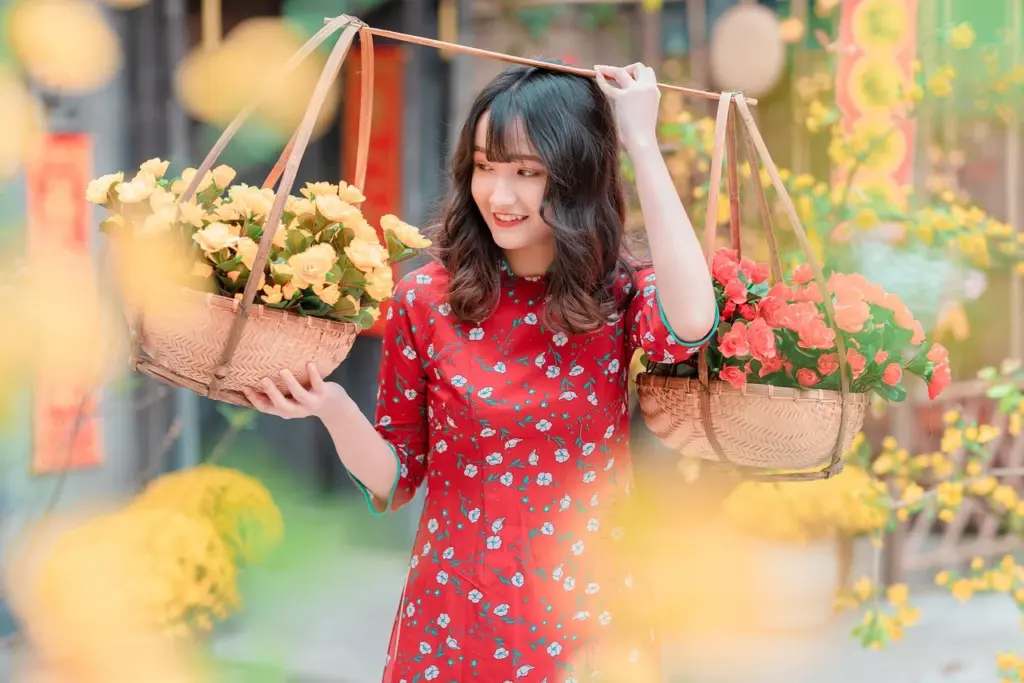
These festivals also provide an opportunity for people to express their deep respect and gratitude to the great leaders of the past who founded and defended the nation.
When you immerse yourself in the festivities, you will have the chance to admire and participate in various rituals, enjoy recreational activities such as boating, tug-of-war, or savor the special dishes prepared exclusively for each festival. What is particularly remarkable about festivals in Vietnam is that they go beyond honoring cultural heritage, they are also a showcase of the endless creativity of the Vietnamese people through elaborate decorations and unique artistic performances. Every festival is typically adorned with vibrant flowers, lanterns, and fireworks meaningful symbols that create a lively and colorful atmosphere.
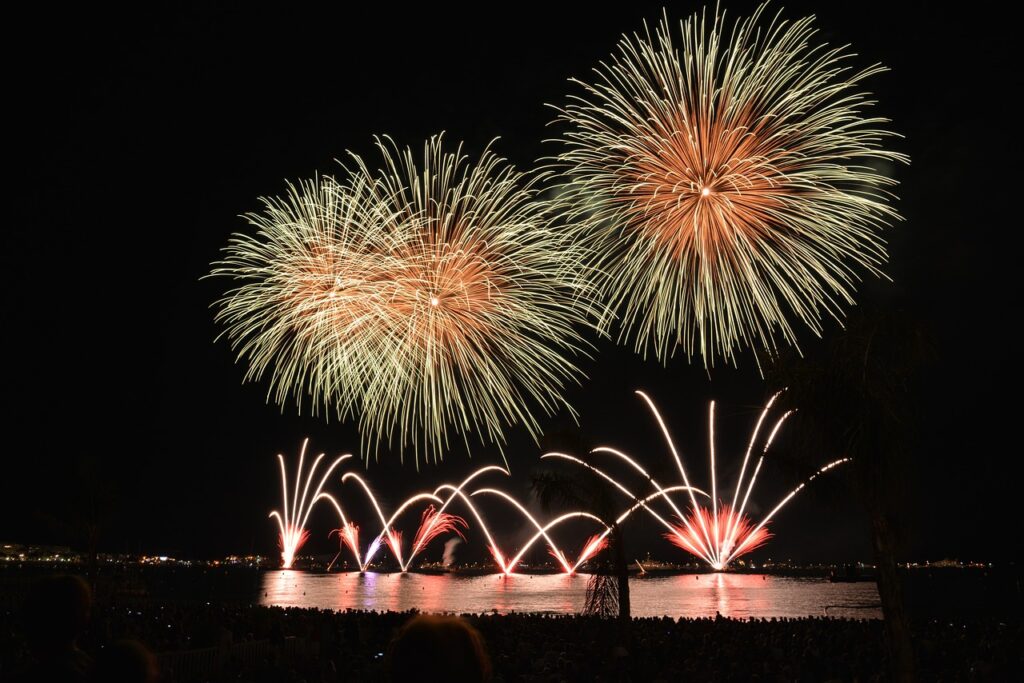
From the past to the present, skilled artisans and craftsmen continue to create exquisite products, sculptures, paintings, calligraphy, and perform traditional dances and music, all driven by the principle of “preserving and promoting the cultural heritage of the Vietnamese people.” This serves as an encouragement for future generations to continue and develop the cultural traditions of their ancestors. This is why festivals in Vietnam are so captivating to tourists. Vietnam has many holidays, but when it comes to traditional festivals? Here are the top 14 traditional festivals in Vietnam that every traveler should experience. These are the largest and most meaningful festivals in the country.
Top 14 Unforgettable Traditional Festivals in Vietnam You Must Experience
Tet Nguyen Dan – Lunar New Year
Top 14 Traditional Festivals in Vietnam
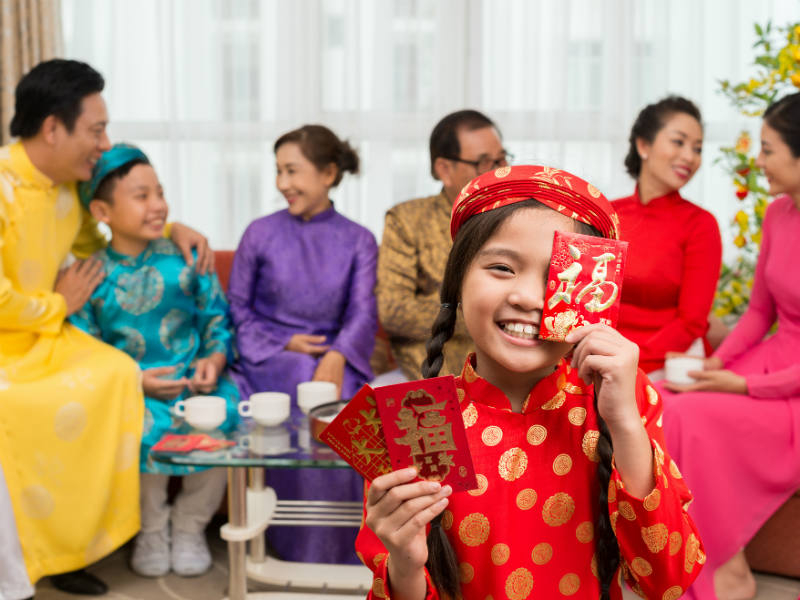
Tết Nguyên Đán, also known as Tết Ta, Traditional Tết, or simply “Tết,” is the most important and largest celebration of the year for the Vietnamese people. It marks the end of the four seasons – Spring, Summer, Autumn, and Winter. In this sacred moment, the transition from the old year to the new one is seen as a renewal of life, a time when everything blossoms and flourishes, bringing the country into a new chapter with countless new beginnings. For the Vietnamese, Tết is a time to cast away the weariness and worries of the past year and to embrace the new year with hopes of prosperity, good fortune, peace, and happiness.
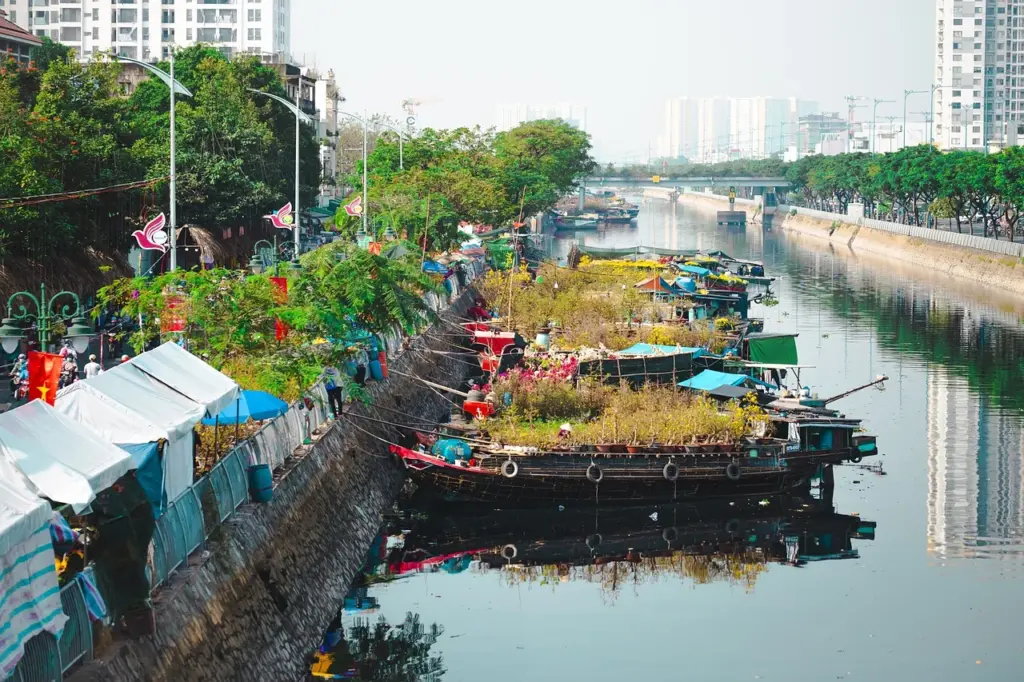
Tết is celebrated on the first day of the Lunar New Year, which falls on the 1st of January according to the lunar calendar. As the biggest holiday of the year, preparations for Tết begin well in advance. People clean and decorate their homes, buy Tết sweets, new clothes for the family, and see off Ông Công, Ông Táo (the Kitchen Gods) to heaven to ensure a prosperous and abundant year. During this time, the streets are filled with the vibrant colors of blooming apricots and peach blossoms, buses, and trains are packed with travelers heading home for the holiday, and the image of women dressed in áo dài (traditional Vietnamese dresses) taking Tết photos is a common sight.
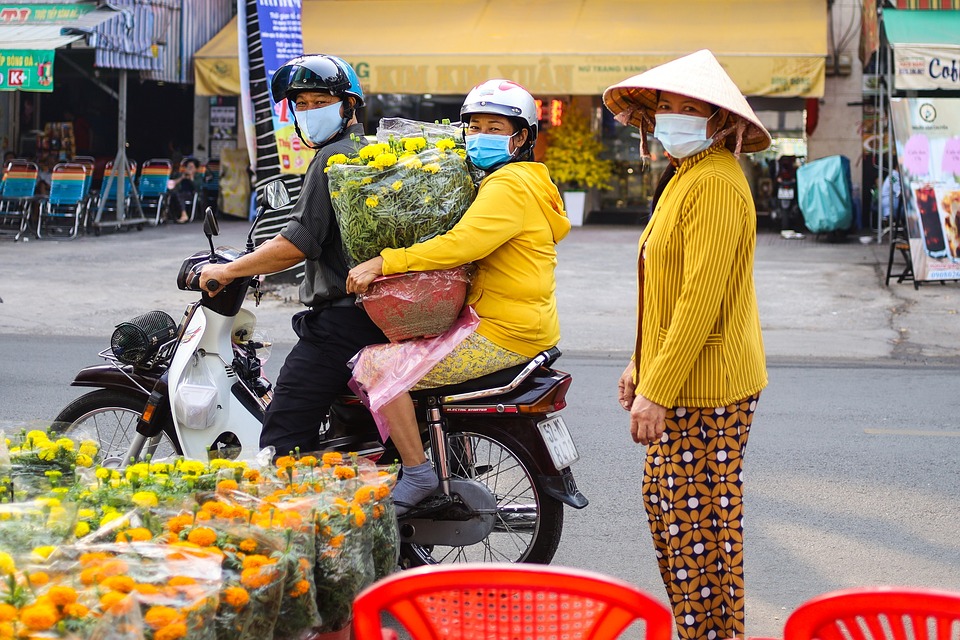

Although Tết doesn’t have a fixed definition, in the hearts and minds of the Vietnamese, it symbolizes family reunions, the joyful moments of New Year’s Eve spent around the bánh chưng (traditional sticky rice cakes) while watching the Táo Quân program on TV, the sound of cheerful Tết wishes, red envelopes given to children, and the laughter that fills every corner of the streets. Tết is not just a holiday — it is a deep-rooted cultural celebration that represents hope, togetherness, and the enduring spirit of the Vietnamese people.
To learn more about Tet, let’s watch this video How the Vietnamese Prepare for Tet Festival
Hung Kings Temple Festival
Top 14 Traditional Festivals in Vietnam
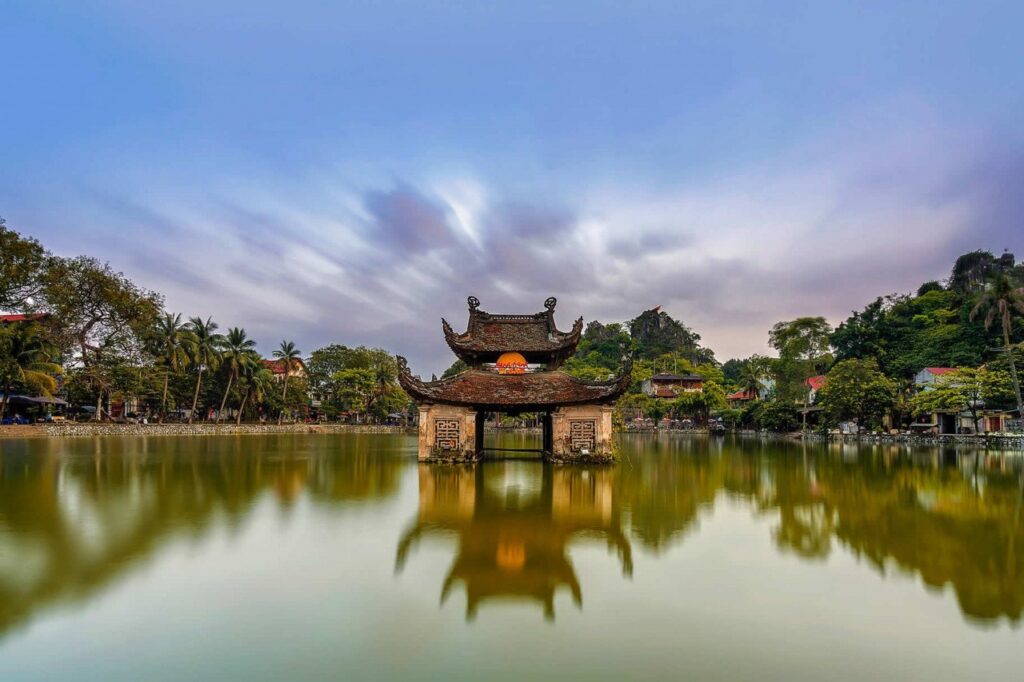
Hung Kings Temple Festival, also known as the Giỗ tổ Hùng Vương (Hung Kings’ Commemoration Day), is one of the most meaningful traditional festivals in Vietnam, carrying deep significance in the cultural and spiritual life of the Vietnamese people. This festival is an occasion to honor and express gratitude to the Hung Kings, who are regarded as the founding ancestors of the Vietnamese nation. They established the Văn Lang Kingdom, laying the first foundation for the birth of the Vietnamese people.

The festival is held annually on the 10th day of the 3rd lunar month at the Đền Hùng (Hung Temple) in Phu Tho Province. It is a time for Vietnamese people to remember their heritage and pay tribute to the leaders who created the early foundations of the nation. One famous folk verse captures the essence of this day:
“Dù ai đi ngược về xuôi
Nhớ ngày Giỗ Tổ mồng mười tháng ba
Khắp miền truyền mãi câu ca
Nước non vẫn nước non nhà ngàn năm”
Provisional translation:
“Whether you travel up or down,
Remember the Hung Kings’ Day on the 10th of the 3rd lunar month.
The song continues to echo across the land,
And the mountains and rivers remain our nation’s heritage for a thousand years.”
This folk verse expresses the sacred feelings and deep gratitude of the Vietnamese people towards the Hung Kings while reminding every descendant of the Vietnamese land of their responsibility to maintain and promote the beautiful traditional values of the nation. The Hung Temple Festival is not only a cultural event but also a symbol of national unity. Every year, on the 10th day of the third lunar month, descendants from all corners of the country, whether living at home or abroad, come together to pay respect to their roots and take pride in their glorious history.
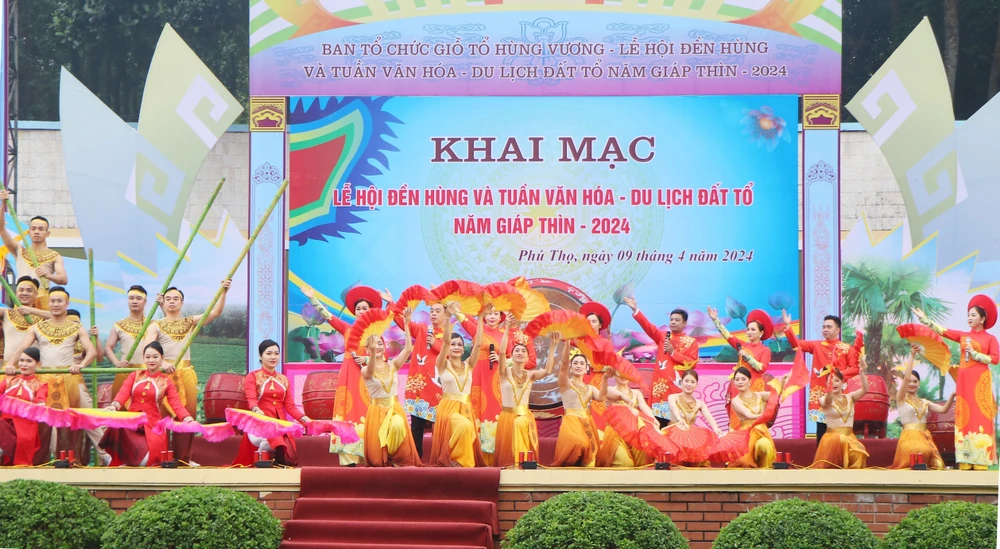
Hung Kings Temple Festival in Vietnam is divided into two main parts: the ceremonial part and the festive part. The ceremonial section is held solemnly with traditional rituals such as offering incense, carrying the palanquin, and reading the prayer by local authorities and elders to honor the contributions of the Hung Kings and pray for national stability and favorable weather. Following this is the festive part, filled with lively cultural events and folk games like making bánh chưng and bánh dày, singing xoan, boat racing, wrestling, and many other traditional games.
For the Vietnamese people, Hung Temple Festival is an occasion to remember their ancestors, and the entire nation must heed the words of President Ho Chi Minh: “The Hung Kings laid the foundation of the nation. We, their descendants, must work together to preserve it.”
Giong Festival in Hanoi
Top 14 Traditional Festivals in Vietnam
Vietnam is a country with a millennium of history, and one of the prominent figures who shaped this glorious history is Thánh Gióng—a legendary hero and a symbol of patriotism with extraordinary strength. According to legend, during the reign of the sixth Hung King, an elderly woman gave birth to a boy after stepping into a large footprint in the field. Strangely, although the boy was three years old, he only lay there and just ate, without speaking or smiling.
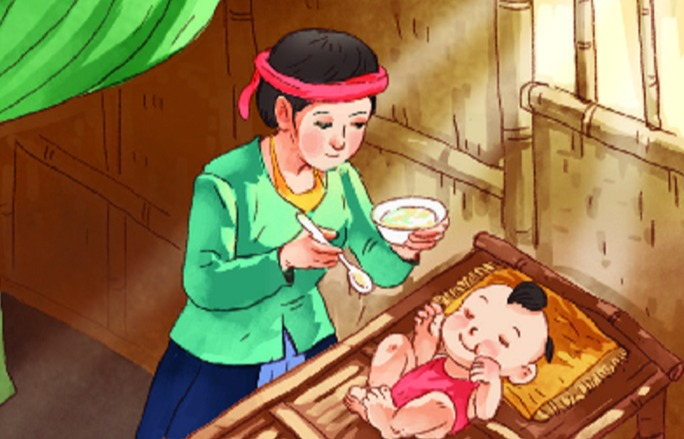
At that time, the Ân invaders suddenly came to invade the land. Hung King decided to issue a decree to find a talented person to save the country. At this moment, the boy suddenly spoke his first words, asking his mother to call the envoy to speak with him. When the envoy arrived and saw a mere three-year-old child, he did not believe the boy could help, but Gióng simply said: “Go tell the king to forge me an iron horse, an iron sword, an iron armor, and an iron helmet, I will drive the enemy away!” Hearing this, the envoy recognized his extraordinary nature and rushed back to inform the king to prepare for battle.
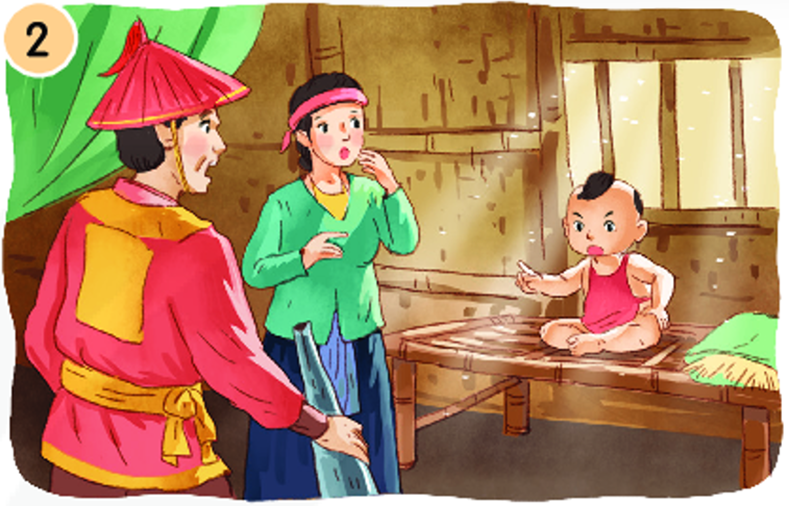
Under the care of his mother, Gióng grew rapidly, soon towering to the ceiling, becoming a strong warrior. He quickly mounted the iron horse and charged into battle, defeating the enemy. When his iron whip broke, he plucked bamboo from the roadside to use as a weapon, continuing to fight until the invaders were completely defeated. After the victory, Thánh Gióng, indifferent to fame and fortune, stopped his horse at the foot of Sóc Sơn mountain, removed his armor, and soared into the sky, transforming into a deity, leaving an eternal mark in the hearts of the people.
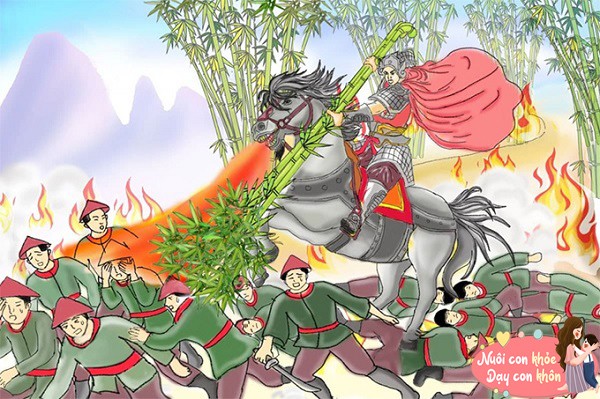
Since then, Hung Kings established a temple dedicated to Thánh Gióng, known as Phù Đổng Temple, at the foot of Sóc Sơn Mountain in Hanoi, and organized the Gióng Festival from the 7th to the 9th days of the fourth lunar month to honor Saint Gióng, who defeated the An invaders, protected the borders, and brought peace to the nation. This is regarded as a major festival in the northern region, featuring many solemn rituals.
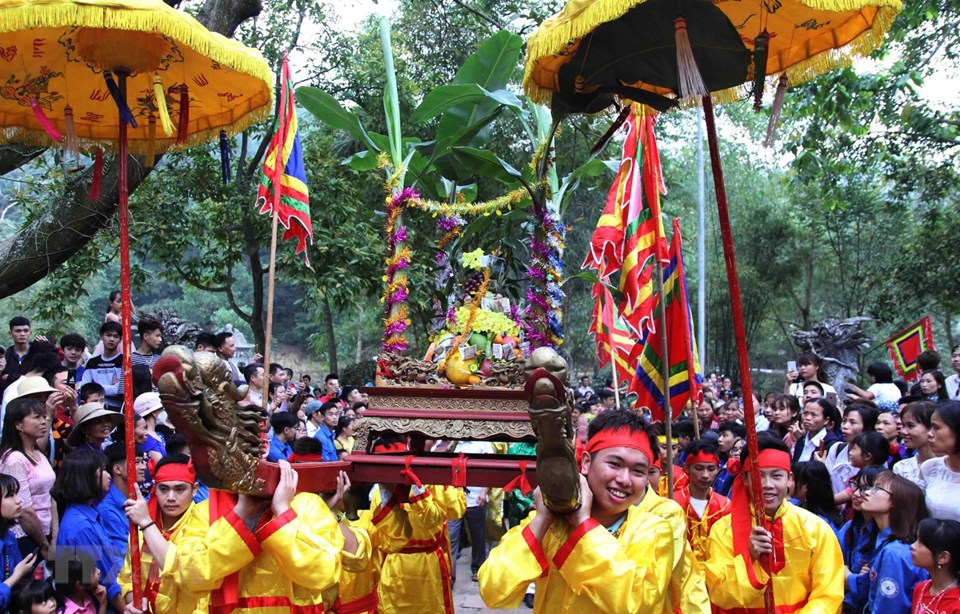
On the opening day of the festival, villagers and visitors from afar offer incense at midnight and bathe the statue of Thánh Gióng at Phù Đổng Temple. This is followed by a ceremony of presenting bamboo flowers to the Sóc Temple. After the flower offering, the bamboo is tossed into the temple courtyard for attendees to take as a symbol of good luck. Then, a representative performs a mock battle, reenacting the scene where Thánh Gióng used bamboo to defeat the enemy general, commemorating the glorious victory from a thousand years ago.
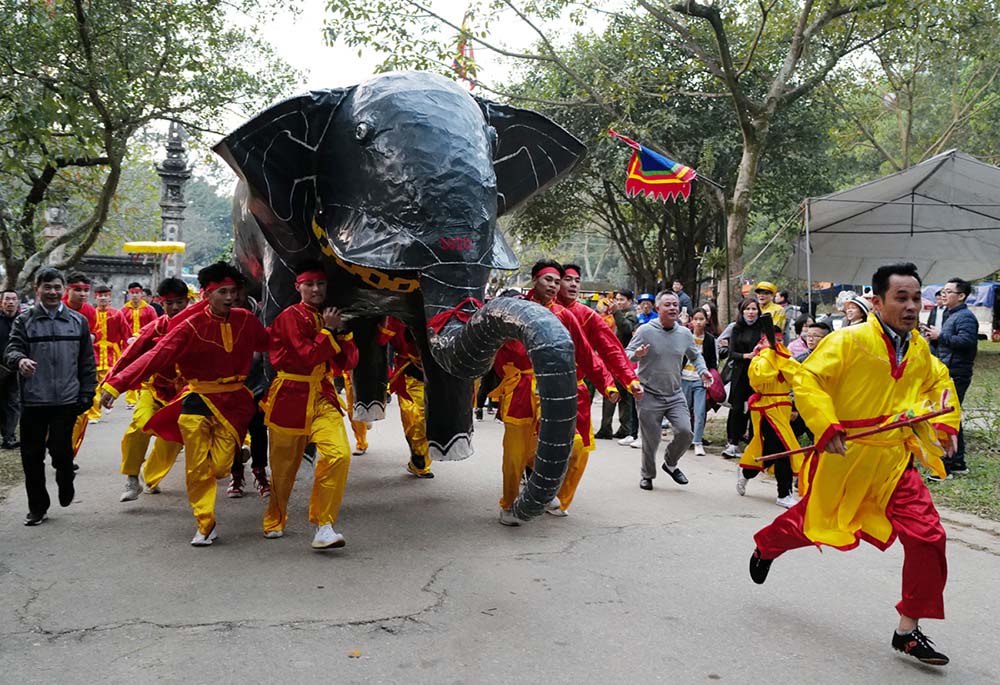
Each year, the festival on 07- 09/4 lunar month attracts many visitors from distant places, becoming an essential celebration for the Vietnamese people. In 2010, the Gióng Festival in Vietnam at Phù Đổng Temple and Sóc Temple was officially recognized by UNESCO as an Intangible Cultural Heritage of Humanity, marking a milestone in the development of Vietnamese culture and history. The love for the nation and the preservation of cultural identity remain guiding principles for Vietnam, regardless of the passage of time.
Reunification Day – A national festival and public holiday in Vietnam
Top 14 Traditional Festivals in Vietnam
April 30, 1975, has gone down in the history of Vietnam as a brilliant milestone, ushering the country into a new era—an era of national independence and socialism. For every Vietnamese person, April 30 is not just a public holiday; it is a deeply sacred day, a day when the entire nation turns its heart toward the homeland. It marks the official achievement of independence and writes a glorious page in history, one that we will always take pride in, even a hundred years from now.
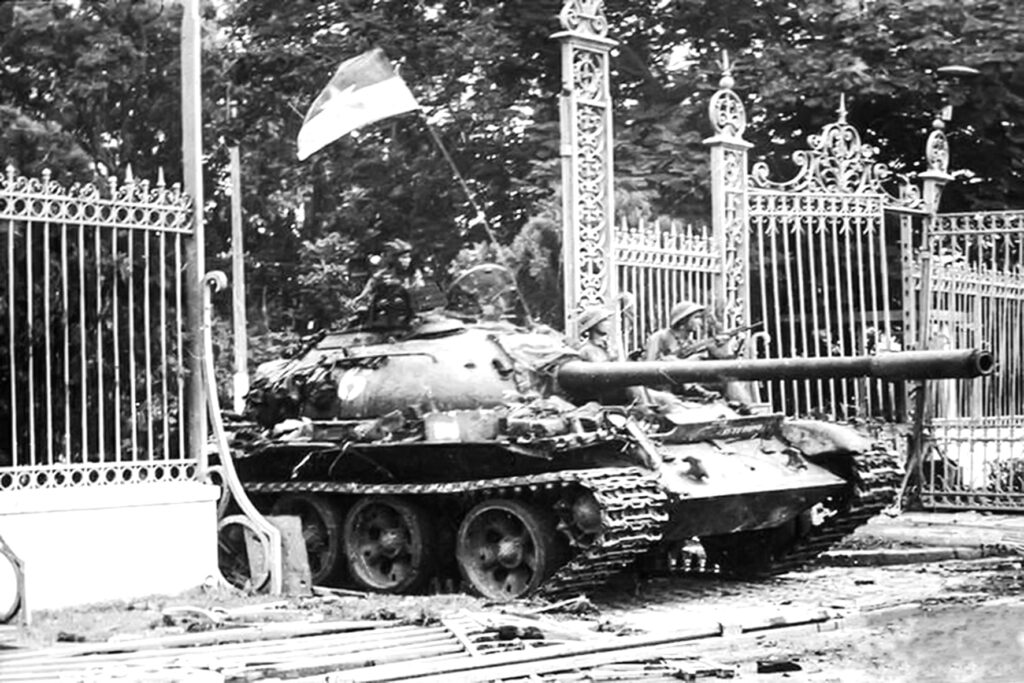
No matter who you are or where you are, as long as you are a child of the Vietnamese land, we will remember the moment at 10:45 AM on April 30, when the image of a tank crashed through the gates of the Independence Palace, when interim President Dương Văn Minh surrendered unconditionally, and when the revolutionary flag waved proudly atop the palace, signaling the complete victory of the Ho Chi Minh Campaign. This day officially marks the reunification of the country and the liberation of the nation.
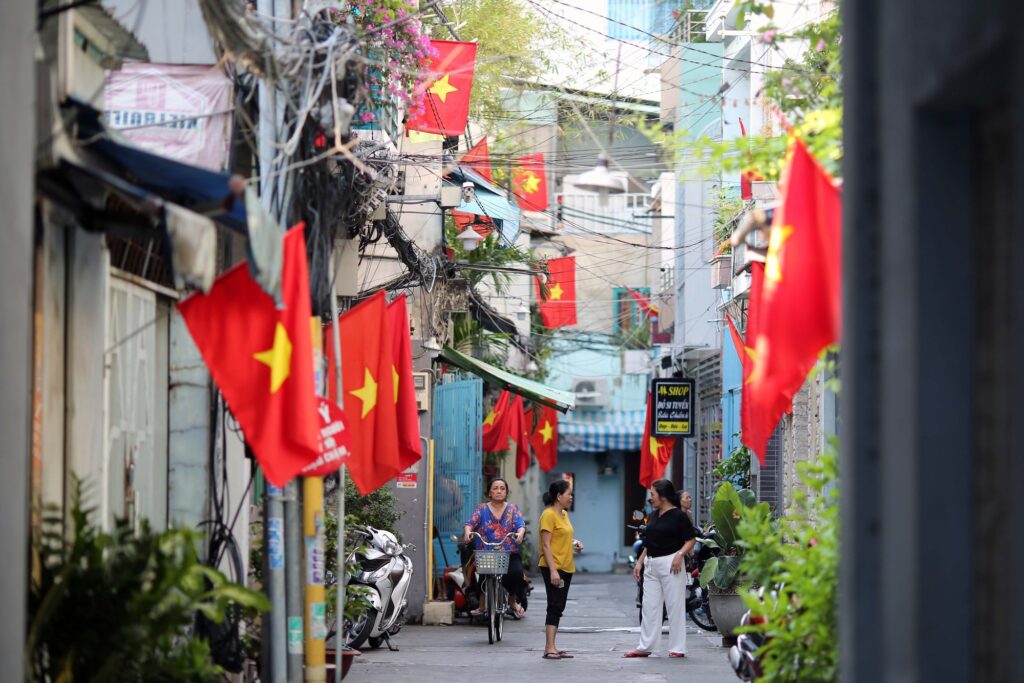
Every year on April 30th, the historic victory of the Spring of 1975 is remembered as a glorious achievement in the struggle against foreign invaders by the Vietnamese people. On this day, the streets of Vietnam are adorned with red and yellow flags, and the national anthem resonates everywhere. Many international friends who visit Vietnam during this time are often surprised and ask, “Why do the Vietnamese love their flag so much?” I can only respond with one answer: “Because it is the blood of my nation.”
The bloodshed by the heroes who fell has deepened the red of the flag, and on this significant day, the fluttering red banners along the roads symbolize those heroes celebrating alongside the nation, marking the day of national independence.
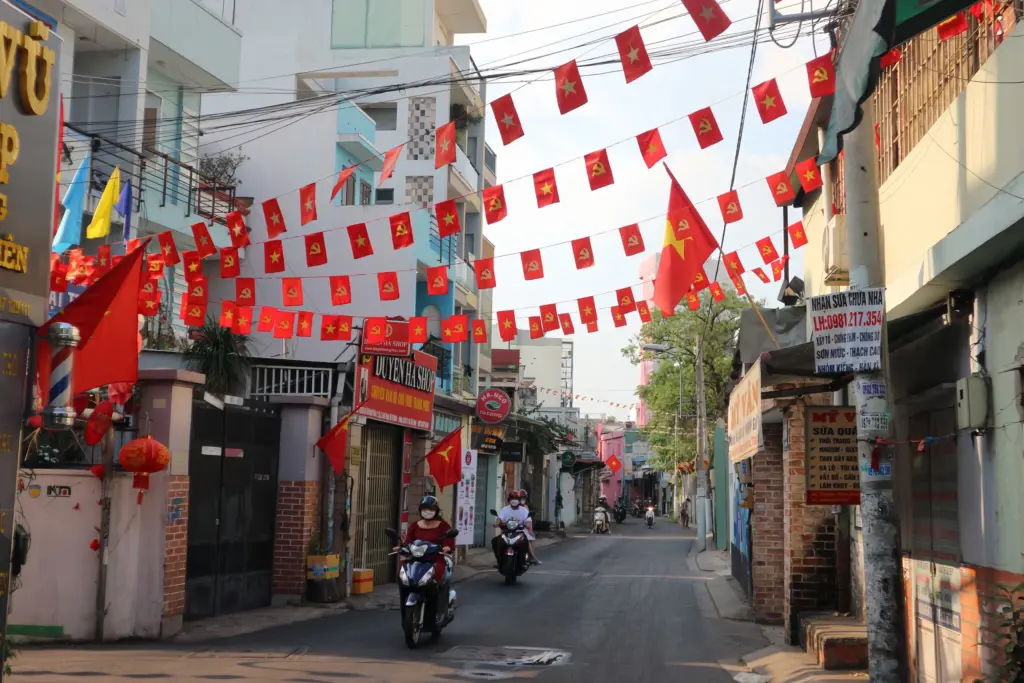
Following April 30th is another meaningful day, May 1st – International Workers’ Day. This day is not only a major holiday in Vietnam but is also celebrated in many countries around the world to honor the contributions of the working class and laborers in building and developing society. Workshops and ceremonies recognizing outstanding individuals and collectives are typically held on this day, providing an opportunity for workers to rest and recharge after days of hard work
Hue Craft Village Festival – Celebrating the Revival of Traditional Crafts
Top 14 Traditional Festivals in Vietnam
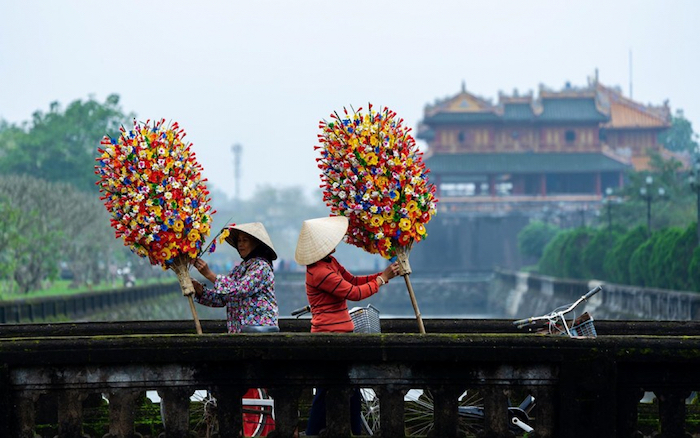
With the rapid development of modern technology today, traditional handmade items are increasingly forgotten. This is why the Traditional Craft Festival was born in Huế, the cradle of traditional crafts. This festival in Vietnam is typically held in May, with the mission of reviving traditional craft villages and honoring the “Essence of Vietnamese Craftsmanship.” The festival attracts over 350 artisans and skilled hands from more than 70 renowned craft villages across the country, along with 37 international artisans.
With the participation of craftsmen from all over, showcasing unique products and skilled techniques, they gently breathe life into each creation, captivating the hearts of visitors and highlighting the diversity and richness of Vietnamese handicrafts.
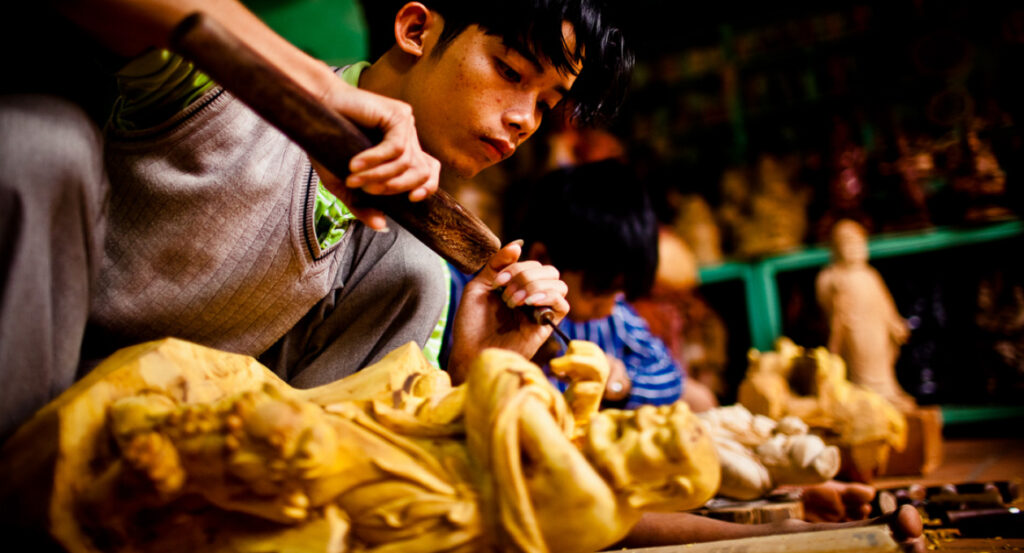
Immersing yourself in the vibrant atmosphere of the festivals in Vietnam, you can admire beautiful handcrafted items ranging from ceramics, embroidered paintings, and woodcraft to textiles, paper flowers, and traditional conical hats—all crafted by the “golden hands” of exceptional artisans. Not only can you observe, but you can also join the craftsmen to experience the process of creating a finished product.

Throughout the process, you will have the opportunity to mold clay for a ceramic vase, carefully embroider each stitch on soft silk, or meticulously shape each paper flower—each step will bring you a unique sensation, helping you not only understand but also deeply appreciate the dedication and talent of these artisans.
Vietnam Ghost Festival or Wandering Souls Day
Top 14 Traditional Festivals in Vietnam
If you have read through the article Religion in Vietnam, you will find that the spiritual culture of the Vietnamese is quite rich. It is not only linked to the worship of ancestors but also reflects the interplay of different cultures and the harmonious combination of major religions such as Buddhism, Taoism, and Confucianism alongside age-old folk beliefs. The Vietnam Ghost Festival, or Wandering Souls Day, is a holiday originating from China.
According to legend, from the second day of the seventh lunar month, the King of Hell orders the opening of the Gate of Ghosts, allowing hungry ghosts to return to the earthly realm until the full moon of the seventh month (15/7), when the gate will close, and the ghosts must return to hell. Therefore, during this time, people tend to avoid going out at night or engaging in taboo activities, fearing disturbances from spirits.
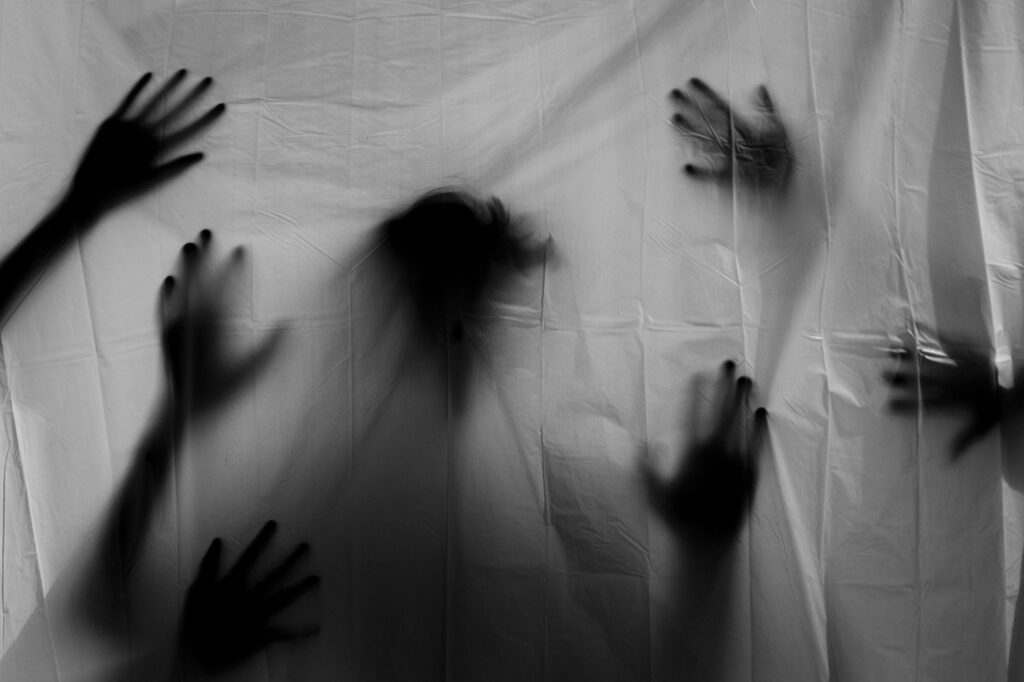
Over the years, the ceremony for wandering souls has become an indispensable ritual for the ethnic Chinese living in Vietnam, especially for businesspeople. They always prepare a lavish offering table as a way to share their misfortunes and provide sustenance for the hungry wandering souls, allowing them to receive offerings, eat well, alleviate their suffering, and hopefully gain liberation. In return, these spirits are believed to bless the host with prosperity.
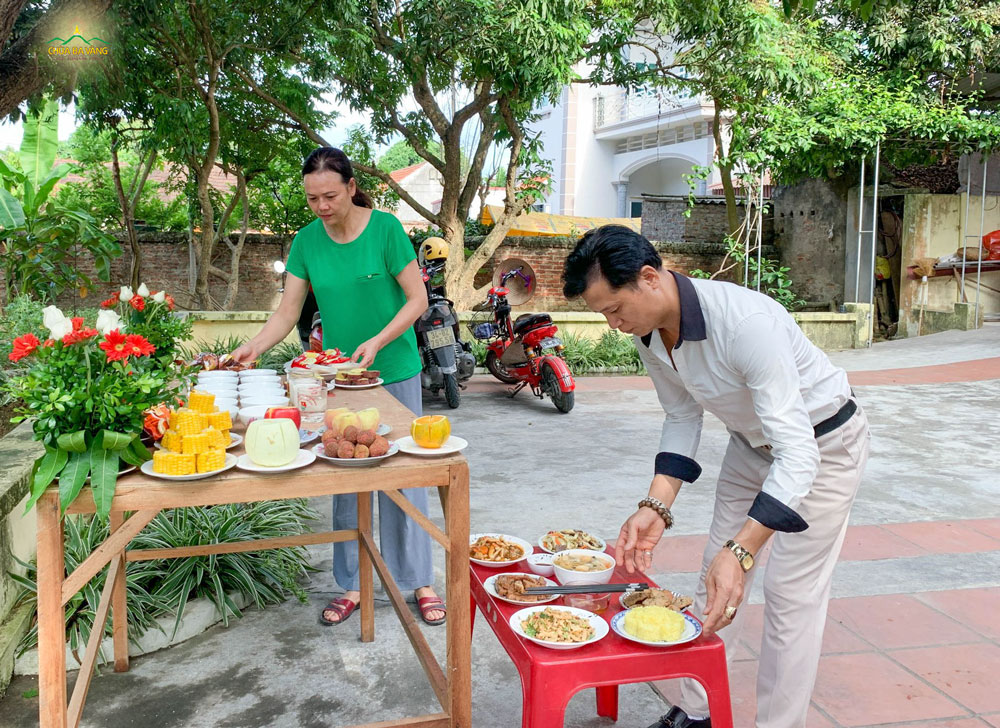
After the ceremony, the host scatters money and salt on the streets for passersby to “receive blessings,” as folk beliefs suggest that if someone takes from the offering table, it helps the host dispel bad luck. Thus, during these days, you can see many people gathering in front of shops that prepare offerings for wandering souls.
Like other ceremonies, the wandering souls ritual has specific guidelines, such as never performing the ceremony indoors and not allowing pregnant women or the elderly (over 60) to participate. This is due to feng shui beliefs that these individuals have lower yang energy, so they should avoid being close to the offering table when the spirits are being honored. At that time, the vengeful spirits rush to fight for food, which could negatively affect the weak energy of the elderly and pregnant individuals.
Vu Lan Festival – Parents’ Day
Top 14 Traditional Festivals in Vietnam
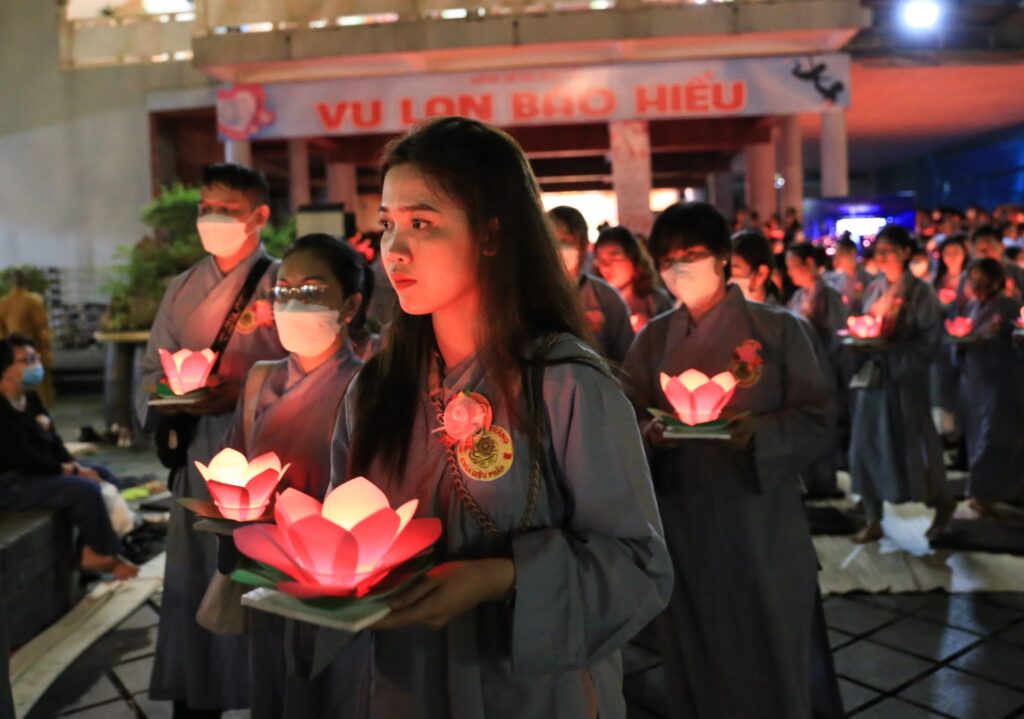
On the full moon of the seventh lunar month, the Vu Lan Festival is celebrated as an important ceremony that carries a profound significance regarding maternal love in Vietnamese culture. This occasion allows every child to express their filial piety toward their parents, whether they are alive or deceased.
To discuss the origins of this meaningful festival, there is a legend about a disciple of the Buddha named Mục Kiền Liên. He was one of the Buddha’s ten great disciples, renowned for his filial devotion and supernatural abilities. He used his powers to search for his mother after she passed away, as he missed her dearly. He discovered that his mother had fallen into the realm of hungry ghosts due to her greed and selfishness during her lifetime, and as a result, she suffered from perpetual hunger and thirst in that realm. Even if food were available, it would turn to fire, making it impossible for her to eat.
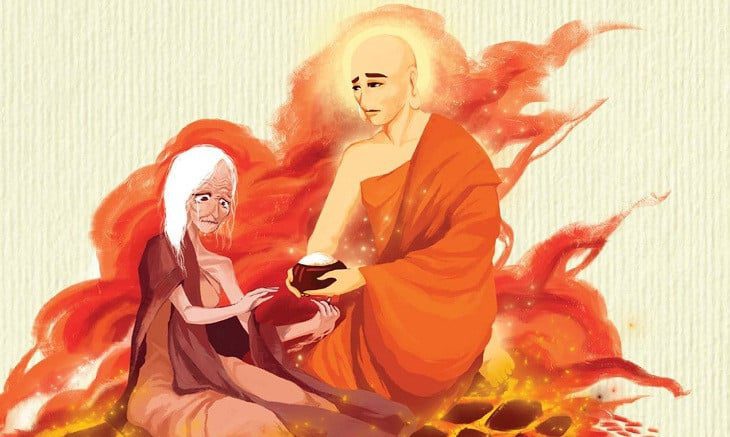
Feeling heartbroken at the sight of his mother suffering, Mục Kiền Liên tried to save her by offering food, but it was to no avail due to the heavy karma she carried. He decided to seek guidance from the Buddha, who advised him that the only way to free his mother from her painful cycle of rebirth was to gather the strength of the monks to pray and make offerings on the full moon of the seventh lunar month.
Following the Buddha’s advice, Mục Kiền Liên prepared offerings and sincerely prayed day and night. Indeed, heaven did not forsake him; thanks to the immense merit of his offerings and his filial devotion, his mother was liberated from the realm of hungry ghosts and reborn into a better existence.
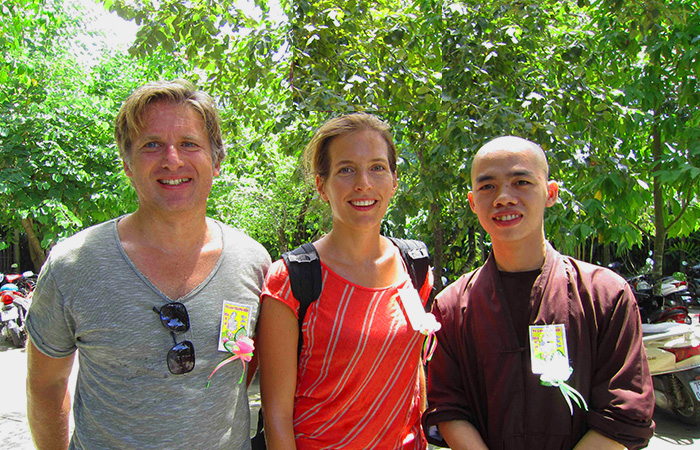
Thus, the Vu Lan Festival in Vietnam was born, becoming a day for children to express their love for their parents. On this day, people often go to temples to offer incense, chant prayers for the deceased, and perform the ritual of pinning a rose on their chest. A red rose is worn by those fortunate enough to still have their parents, serving as a reminder to cherish every precious moment with them. A pink rose is for those who have lost a father or mother, symbolizing sorrow and gratitude. In contrast, a white rose represents deep remembrance and appreciation for parents who have passed away.
The bond of motherhood and fatherhood is the most sacred connection, nurturing and uniting individuals throughout their lives. It is an irreplaceable love, a source of affection and unconditional protection. Wearing a vibrant red rose on one’s chest is a great happiness, a symbol of the fortune of living in the loving embrace of one’s parents. For this reason, I would like to share with you the following heartfelt poem as a sincere message to all children:
“Ai còn mẹ, xin đừng làm mẹ khóc
Đừng để buồn lên mắt mẹ nghe chưa”
Provisional translation:
“Those who still have their mothers, please do not make her cry.
Do not let sadness fill your mother’s eyes, understand?”
Independence Day – National Day in Vietnam
Top 14 Traditional Festivals in Vietnam
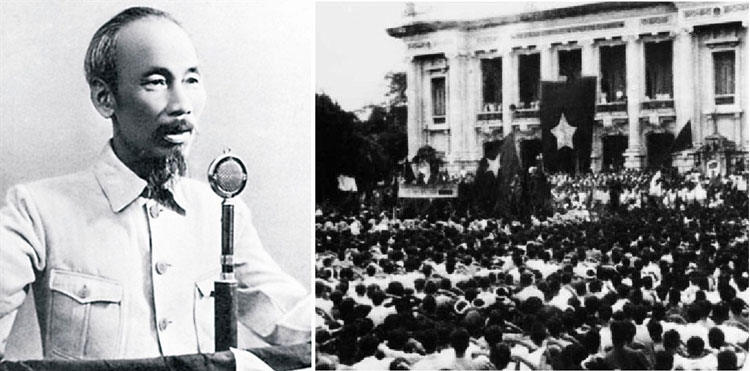
If April 30, 1975, is the day of national liberation, then September 2, 1945, is the day the state of Vietnam was born. September 2, 1945, is not only a glorious milestone in the history of the Vietnamese nation but also a symbol of the indomitable spirit and the desire for freedom and independence of the people. On this day, at the historic Ba Đình Square, before tens of thousands of compatriots, President Hồ Chí Minh solemnly read the Declaration of Independence, marking the birth of the Democratic Republic of Vietnam amid the cheers of the entire nation.
The declaration clearly stated and affirmed the rights to life, freedom, and the pursuit of happiness for all people, aiming for a country that is Independent – Free – Happy.
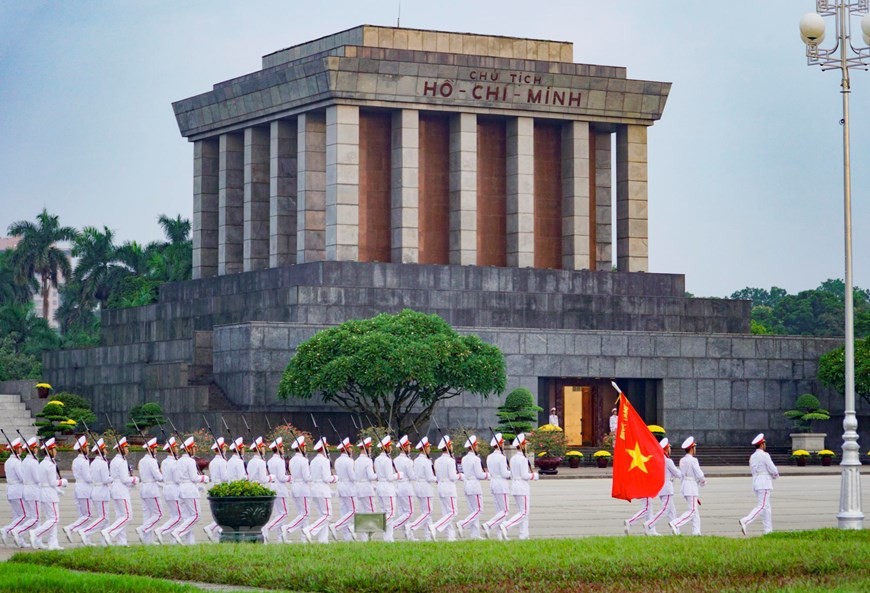
Every year on September 2, the entire nation remembers this sacred day, a day when heaven and earth seem to join in the joy of the people. The red and yellow flag waves proudly, the majestic national anthem resonates, blending with the tears of happiness from the people after years of arduous struggle. In addition to being National Day, September 2 also carries another deeply significant meaning, as it marks the day President Hồ Chí Minh—the great leader, the beloved father of the nation—permanently left the Vietnamese people. Bác Hồ took his last breath at 9:47 AM on September 2, 1969, leaving behind boundless sorrow for the entire Vietnamese people.
The passing of Bác Hồ on National Day makes this day more meaningful than ever. On this significant occasion, every Vietnamese person not only feels proud of the glorious history but also remembers the immense contributions of Bác Hồ—who devoted his entire life to the independence and freedom of the homeland and the happiness of the people.
Every year on September 2, people from all over the country gather at the historic Ba Đình Square, where the image of their beloved leader is preserved. They solemnly assemble at Bác Hồ’s mausoleum to attend the flag-raising ceremony early in the morning, listening to the national anthem as a song of peace for the nation.
Mid-Autumn Festival
Top 14 Traditional Festivals in Vietnam
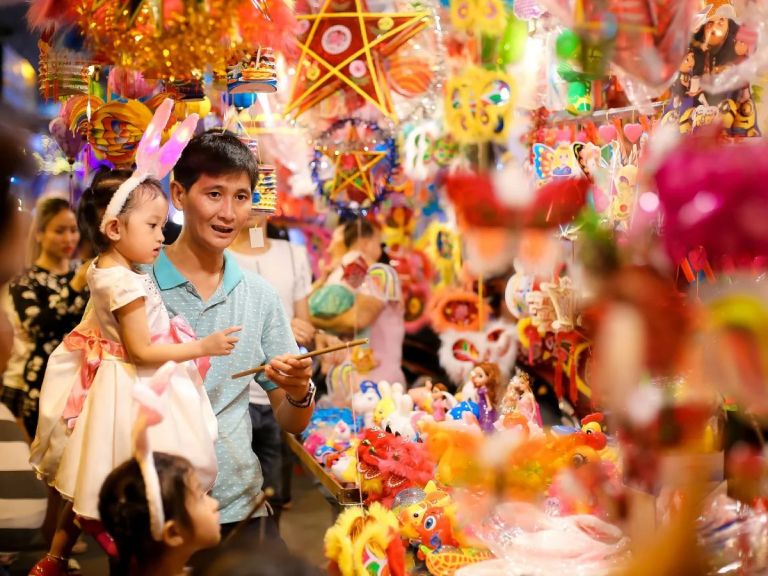
The Mid-Autumn Festival, or Tết Trung Thu, is one of the most popular festivals in Vietnam, celebrated on the full moon of the eighth lunar month each year. This is a special occasion that children everywhere eagerly anticipate to enjoy mooncakes, gather and play with friends, carry shimmering lanterns, and watch lively lion dances throughout the village streets.
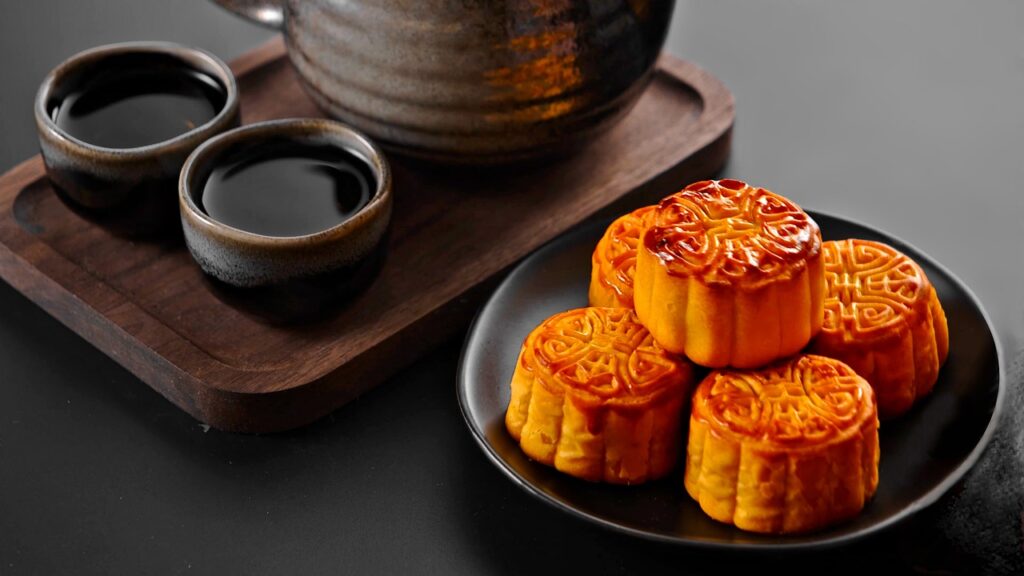
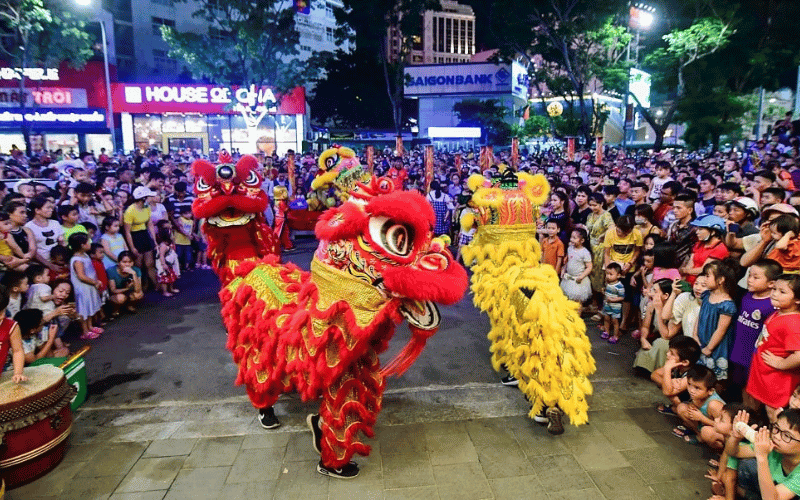
The customs surrounding the Mid-Autumn Festival have existed for a long time, and there is a famous legend that every child in Vietnam knows—“The Legend of Chú Cuội.”
The legend tells of a poor woodcutter named Cuội who earned a living by chopping firewood. One day, Cuội accidentally saved a miraculous banyan tree that had the ability to cure all ailments. Thanks to this banyan tree, Cuội was able to save many people, including a dog and the daughter of a wealthy man. In gratitude, the wealthy man decided to marry his daughter to Cuội.
However, Cuội’s wife was very beautiful, which made the local young men envious and conspire to harm her. One day, while Cuội was out chopping wood in the forest, the young men broke into Cuội’s house, killed his wife, and threw her entrails into the river to prevent Cuội from saving her. When Cuội returned and discovered that his wife had passed away, he was heartbroken. He hurriedly tried to revive her with medicine, but no matter how many leaves he fed her, she could not come back to life.
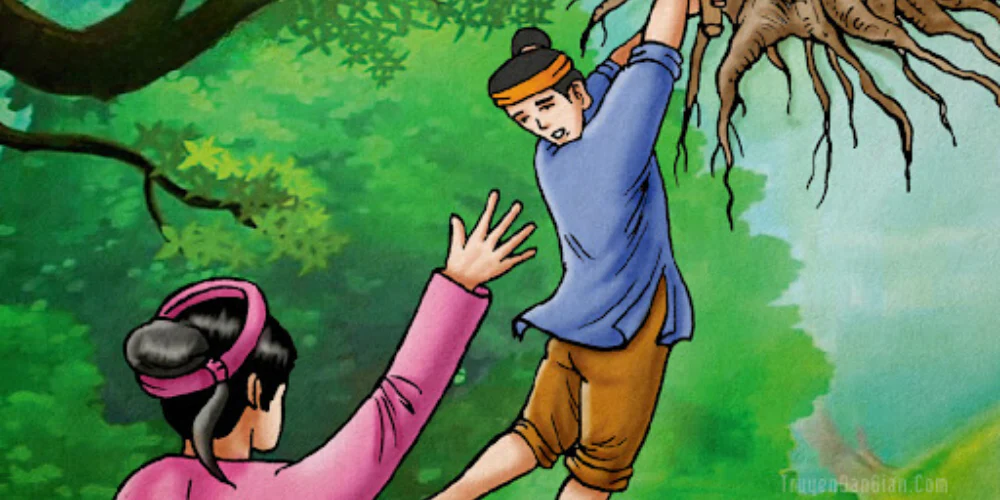
Seeing this, the dog beside him wanted to offer its own entrails to save her, and surprisingly, Cuội’s wife was able to revive. However, after coming back to life, she became confused and could not distinguish directions. She accidentally watered the banyan tree with dirty water, causing it to uproot and slowly float up into the sky. When Cuội returned home and saw this, he rushed to hold onto the base of the tree, but it continued to pull him up to the moon. Since then, every Mid-Autumn Festival, people occasionally see the image of Chú Cuội sitting against his banyan tree.
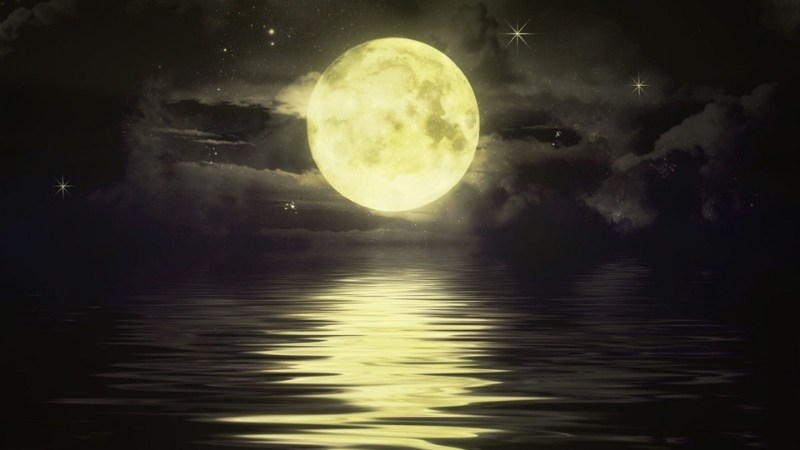
The Mid-Autumn Festival in Vietnam is not only a time for family reunions but also a moment to remember the legend of Cuội, symbols tied to childhood memories, loyalty, and love for one’s homeland. This is why the Mid-Autumn Festival is a celebration of familial bonds, affection, and faith in miracles, even in the most challenging circumstances.
Lim Festival – A unique cultural experience you can’t miss in Vietnam
Top 14 Traditional Festivals in Vietnam
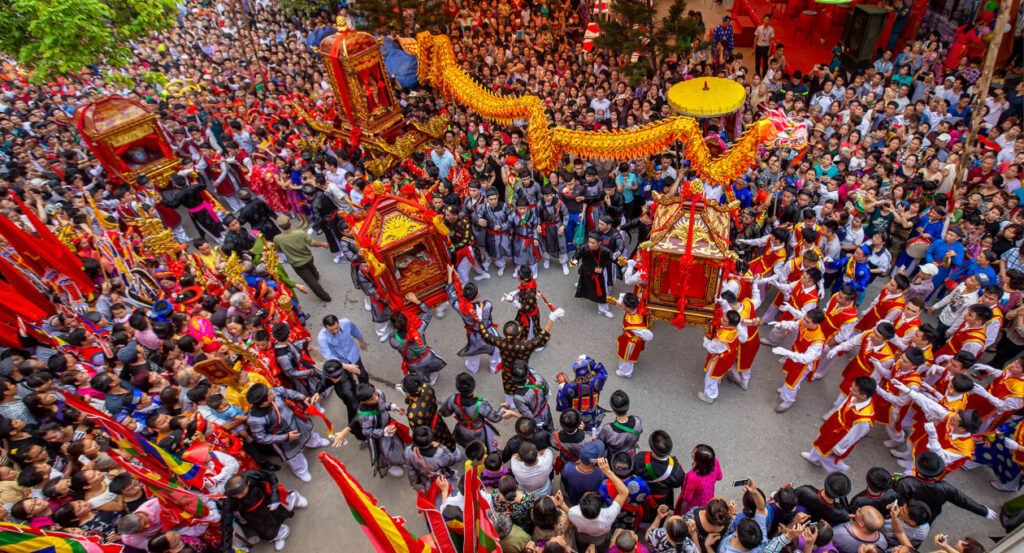
Among the traditional festivals in Vietnam, the Lim Festival is one of the most distinctive spring festivals, embodying the cultural identity of Bac Ninh – Kinh Bac region. Held annually on the 12th and 13th days of the first lunar month, the Lim Festival allows locals and visitors to immerse themselves in the unique cultural atmosphere of Quan Ho folk singing—a UNESCO-recognized intangible cultural heritage.
The Lim Festival is not only about music, it also captivates with its traditional rituals rich in spiritual and religious significance. The ceremonial part includes activities such as processions and offering incense at Lim Pagoda to show respect to deities, ancestors, and national heroes. After the ceremony, the festive part brings the atmosphere to a climax, featuring folk games and vibrant artistic exchanges.
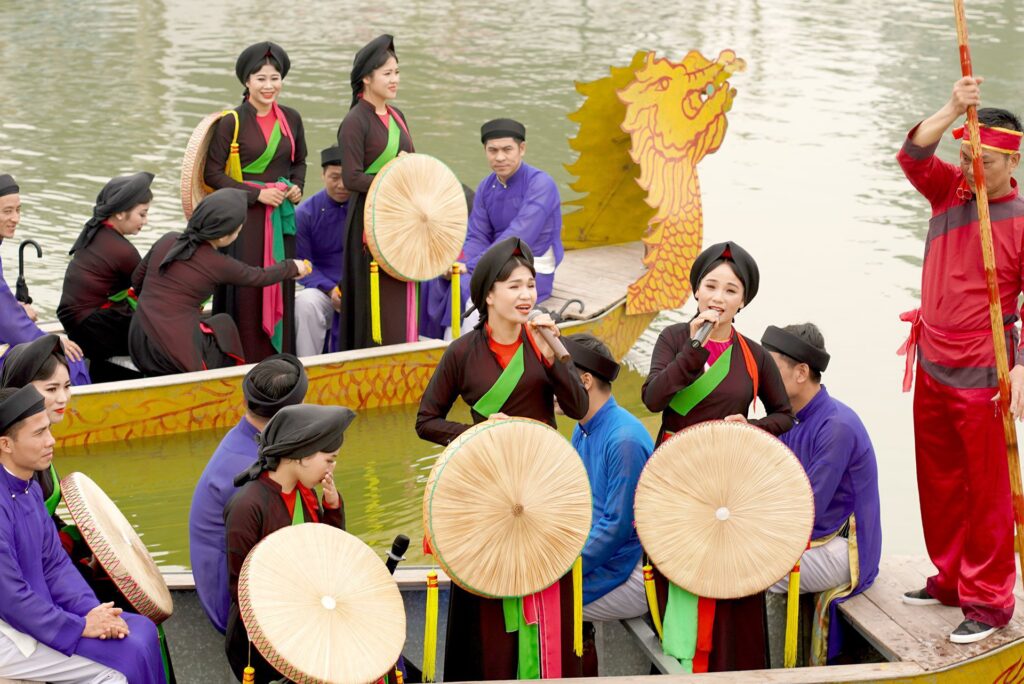
The highlight of the festival is the Quan Ho singing competitions between men and women from various Quan Ho villages in the area. Dressed in traditional attire, with long dresses and headscarves, they respond to each other with beautifully lyrical songs, showcasing their grace and cleverness in improvisation. The Quan Ho songs range from sweet and tender to lively and cheerful, enchanting anyone who listens.
In addition to Quan Ho singing, the festival also features many traditional folk games such as wrestling, tug of war, swings, human chess, and the tossing of con (a traditional game). Each game carries its own unique color and meaning, helping to strengthen community bonds and preserve distinctive cultural values. Therefore, the Lim Festival remains an annual cultural event that attracts a large number of participants from both within the country and abroad.
Hoi An Lantern Festival
Top 14 Traditional Festivals in Vietnam
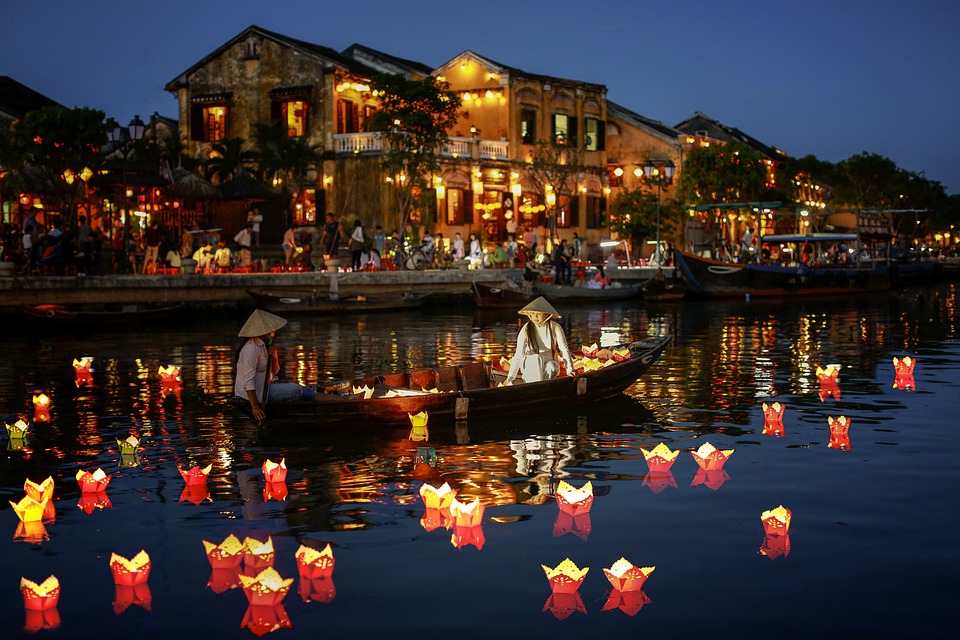
Hoi An Lantern Festival, also known as the Lantern Festival, is one of the well-known festivals in Vietnam that is loved by many Vietnamese people and tourists. When visiting Vietnam, you definitely should stop by this place at least once because the scenery of the lanterns is truly unique.
Looking back to the 16th century, when Hoi An was still a bustling trading port, many merchants came here and brought lanterns to hang in front of their shops. Over time, the local people embraced this culture and began to hang lanterns in front of their homes as a way of wishing for good fortune. By 1988, when this practice had become ingrained in the culture of the Vietnamese, the local government decided to organize the Lantern Festival on the full moon of each month. Since then, this festival become it is one of the famous festivals in Vietnam and has continued to grow and is celebrated to this day.
Lantern Festival in the ancient town of Hoi An is a vibrant activity that reflects the local cultural identity, helping to preserve the traditional values of the people here. The lanterns symbolize peace and also carry wishes for good luck for every family. At some famous tourist spots in Hội An, visitors have the opportunity to participate in the lantern-floating ceremony to make wishes for a better and happier life.
Buddha’s Birthday – One of the most significant Vietnam festivals
Top 14 Traditional Festivals in Vietnam
Every year, on the full moon of May in the Gregorian calendar, which falls on the 15th day of the fourth lunar month, millions of Buddhists around the world commemorate and honor the birthday of Gautama Buddha. According to legend, the Buddha was not born from the womb of Queen Maya; instead, upon his birth, he took seven steps, and with each step, a lotus flower bloomed beneath his feet, and he was named Siddhartha.
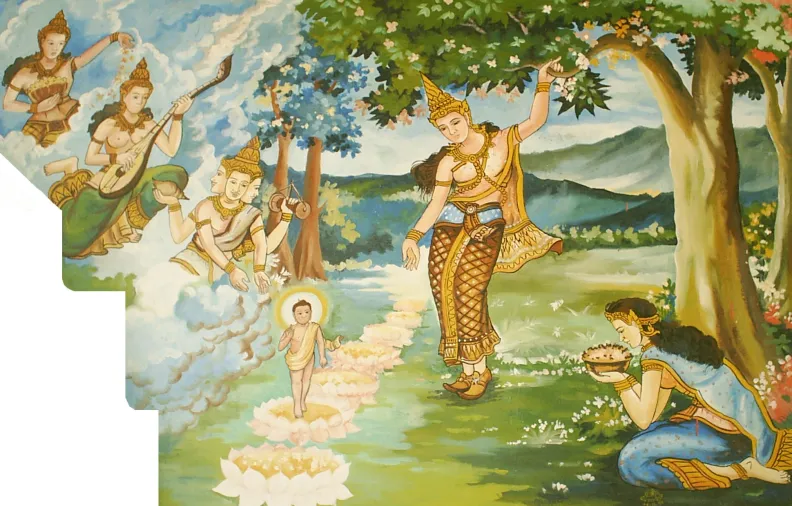
Although he was born a prince and lived in a lavish palace, he was always troubled by the meaning of life and the suffering that humanity endures. His excursions outside the palace exposed him to the realities of aging, illness, and death, awakening in him a deep desire to seek the truth and a path to liberation from suffering.
At the age of 29, after bidding farewell to his wife and child and renouncing all fame, power, and wealth, the prince left the palace to begin his journey of meditation. For six long years, he underwent severe forms of asceticism, with the sole hope of discovering the path to enlightenment. However, after years of extreme self-denial, his body became emaciated, his health deteriorated, and the truth still eluded him. He realized that extreme asceticism was not the way to achieve enlightenment. This was when he clearly understood that he needed to pursue a different path—the Middle Way, which avoids both indulgence in sensual pleasures and extreme self-mortification.
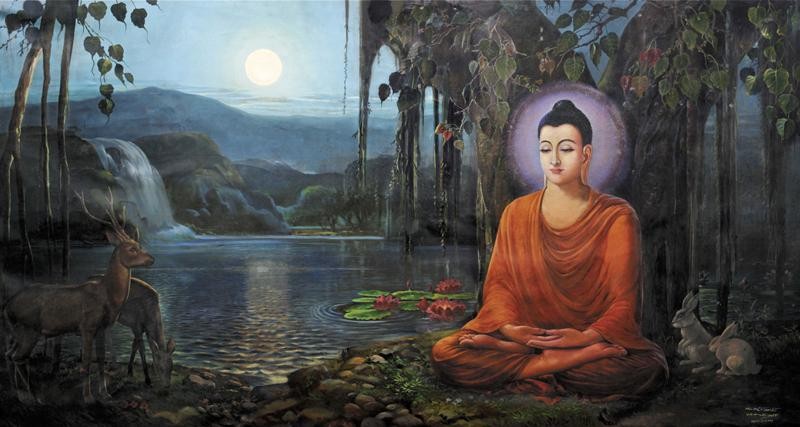
Determined, he sat under the Bodhi tree through 49 days of profound meditation and faced various temptations and trials presented by Mara. With sharp intellect and boundless compassion, he overcame all obstacles and attained supreme enlightenment, becoming Gautama Buddha. He comprehended the nature of suffering and the path to liberation, understanding the law of dependent origination and the impermanent nature of all things.
After attaining enlightenment, the Buddha did not keep this precious truth to himself; instead, he began a journey to spread his teachings far and wide, from cities to rural areas, and from royalty to commoners. For over 45 years, he tirelessly taught, sharing compassion, wisdom, and truth, leaving an indelible mark on history and humanity. His teachings not only saved millions of people at that time but continued to illuminate the hearts of billions across the millennia.
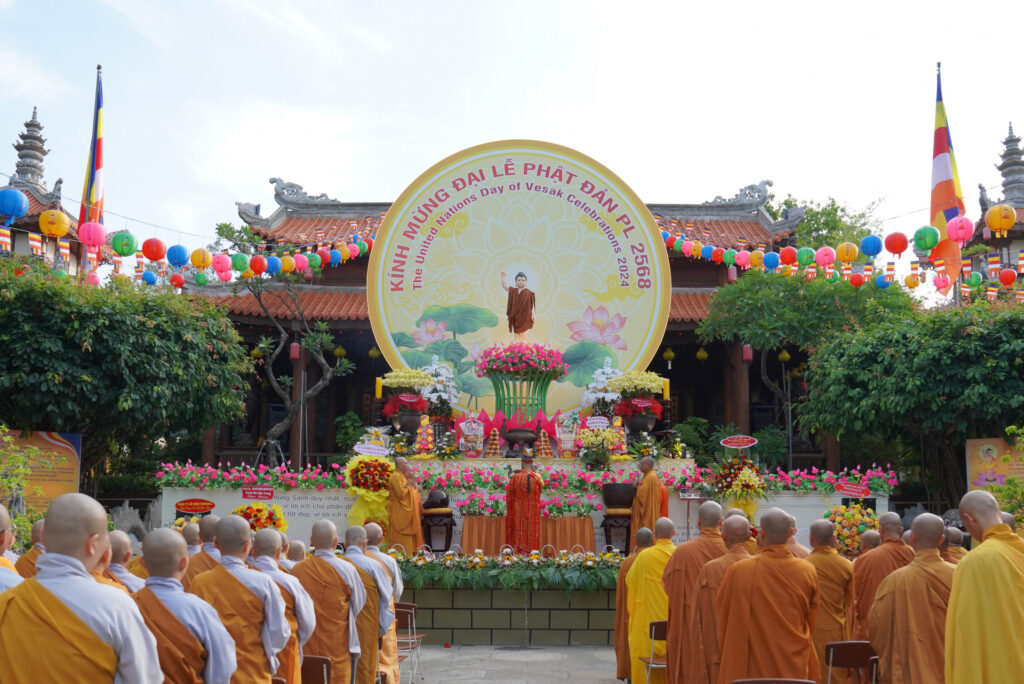
Today, the Buddha’s Birthday is one of the popular festivals in Vietnam celebration, from large temples to the smallest corners of Buddhist communities, there is an atmosphere filled with sacredness and solemnity. On this day, people typically eat vegetarian meals and release animals as an expression of compassion and to sow seeds of goodness in their lives.
Immersed in the festive atmosphere of Buddha’s Birthday, besides enjoying cultural performances and floating lanterns, you will not find it difficult to encounter beautifully decorated processions parading through the streets, carrying statues of the Buddha and embodying a great aspiration for faith—a faith in a life enlightened by compassion, wisdom, and liberation from all suffering.
Perfume Pagoda Festival
Top 14 Traditional Festivals in Vietnam
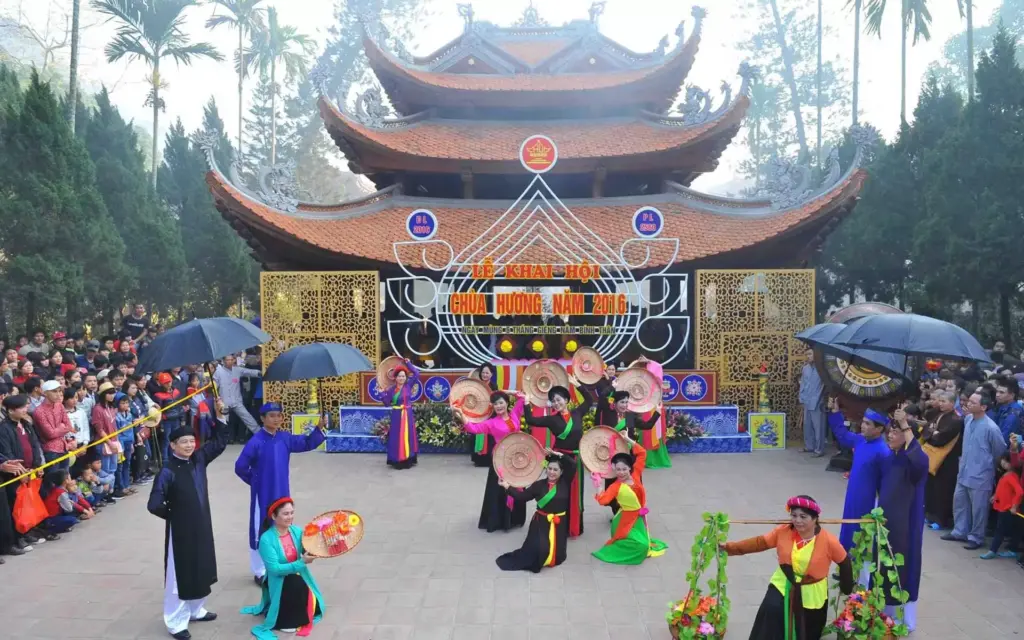
When it comes to spiritual festivals, the Hương Pagoda Festival in Vietnam is certainly one that cannot be overlooked. The festival takes place annually during the spring season in Huong Son Commune, My Duc District, Hanoi. It is not only a spiritual festival but also a place where both Vietnamese people and foreign tourists come to seek a connection to the Buddhist realm, offering incense and prayers while immersing themselves in the magnificent natural surroundings.
The festival lasts from the sixth day of the Lunar New Year until the end of the third lunar month, featuring activities such as visiting sacred temples, pagodas, and caves, as well as enjoying the stunning beauty of the Hương Sơn mountains and forests. Hương Pagoda stands out not only for its harmonious architecture blending with nature but also as a deep repository of Buddhist cultural traditions.
During the festival, visitors can participate in rituals of offering incense, praying to the Buddha, floating boats on the river, climbing mountains to visit caves and pagodas, and exploring intriguing legends. If you are seeking healing and tranquility, this is undoubtedly an attractive destination to relax your soul and experience the spiritual beauty of the Buddhist realm.
Khau Vai Love Market Festival in Ha Giang
Top 14 Traditional Festivals in Vietnam
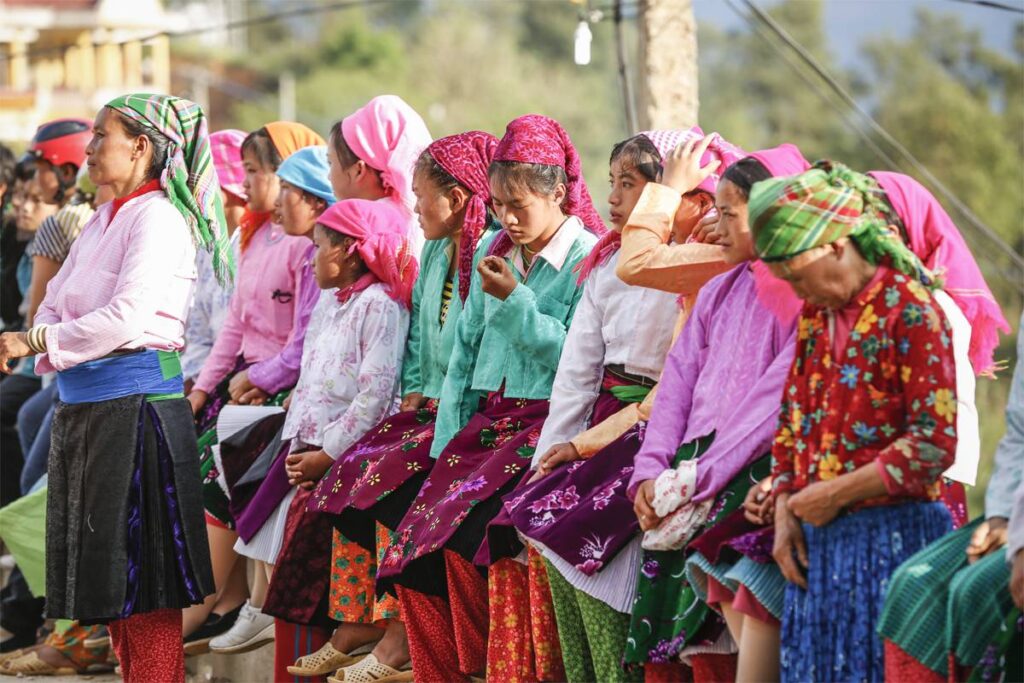
Have you ever heard of a market where buying and selling aren’t important, yet it has existed for over 100 years? Hold your surprise, I will take you to the Khau Vai Love Market Festival in Ha Giang – a very unique cultural feature of the ethnic minorities in Vietnam. The origin of this market is tied to a touching love story and a long-standing tradition that the locals have preserved through generations.
The story goes that there once was a deeply in-love couple who, due to differences in family background and customs, were prevented by their families from being together. However, longing for each other, they escaped to Khau Vai Mountain to hide and survive. But after they left, their families began to quarrel, leading the couple to heartbreakingly part ways and return to fulfill their duties to their clans. From that point on, they decided to meet once a year on the 27th day of the third lunar month to sing to each other and share stories about their lives during the years of separation.
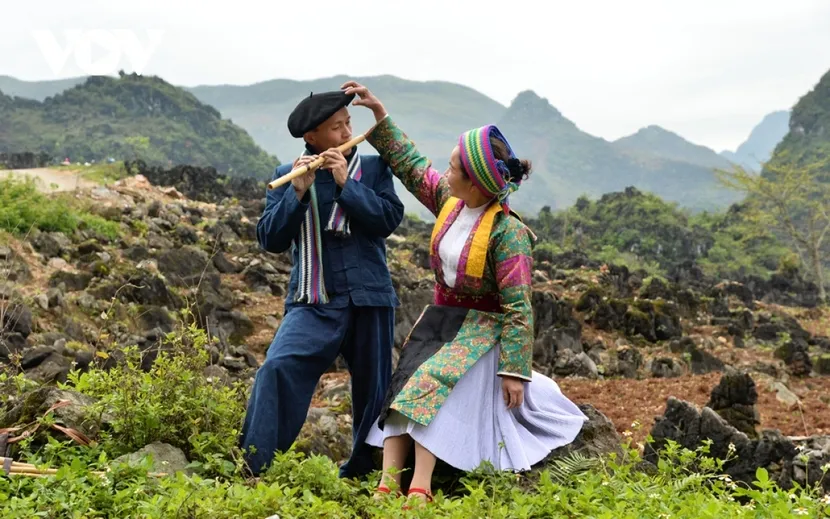
Even after many decades, every year on the 27th day of the third lunar month, the locals eagerly dress up to attend the Khau Vai Love Market festivals in Vietnam, continuing the tradition of that couple from long ago. Even if they have families and children, those who once loved each other keep the promise to reunite on this day each year, to rekindle old feelings and share the thoughts accumulated during their time apart. They do not need to give each other material gifts; simply seeing one another, listening to heartfelt songs, and holding hands once again under the vast sky of Khau Vai is enough.
If you want to travel to Ho Chi Minh City. These articles will help you learn more about our city:
Let’s Immerse Yourself in the Traditional Festivals of Vietnam at Least Once in Your Lifetime
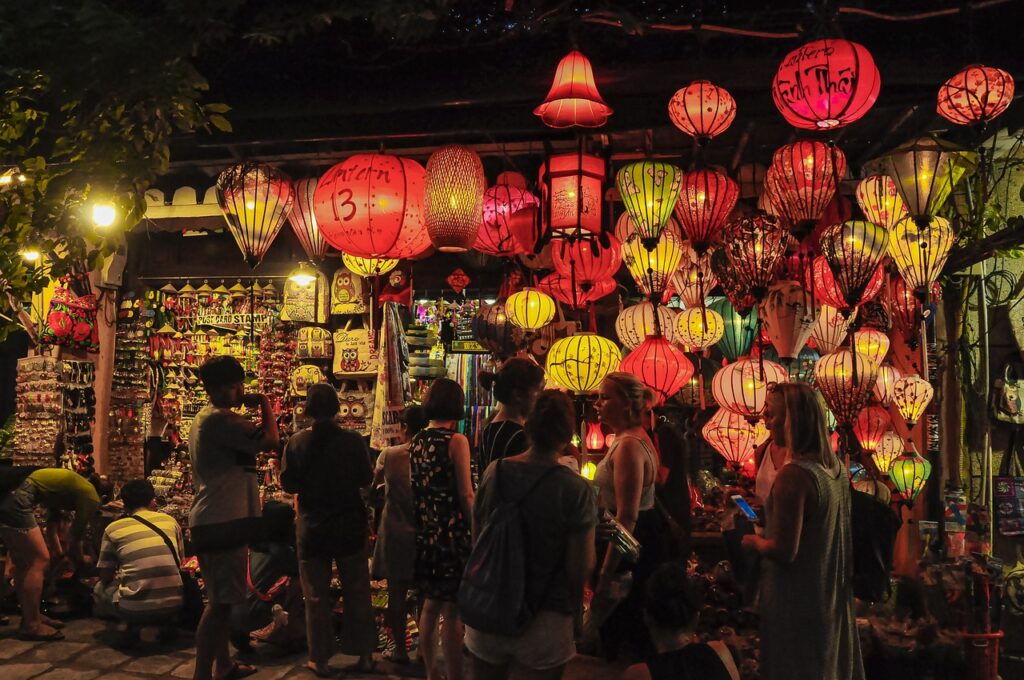
It is no exaggeration to say that Vietnam is a country with an incredibly diverse culture. Each region and each ethnic group carries its own unique identities, customs, and traditional festivals. From nationwide celebrations such as Tet Nguyen Dan and the reunification day to the northern mountainous regions with the Khau Vai Love Market to the central region with distinctive festivals like the Hoi An Lantern Festival, and the southern region with the Hung Kings’ Festival, all of these create a rich and colorful cultural tapestry.
What are you waiting for? Join the festivals in Vietnam with Jackfruit! If you have the chance to immerse yourself in the atmosphere of these festivals, you will understand why the Vietnamese people hold a deep pride and boundless love for their ancient cultural heritage, perfectly embodying the saying: “Culture is the root, culture is the nation, as long as culture exists, the nation exists.”




